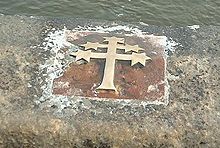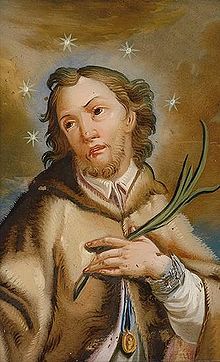|
John of Nepomuk
John of Nepomuk (or John Nepomucene) (Czech: Jan Nepomucký; German: Johannes Nepomuk; Latin: Ioannes Nepomucenus[1]) (c. 1345 – 20 March 1393)[2] was a saint of Bohemia (Czech Republic) who was drowned in the Vltava river at the behest of King Wenceslaus IV of Bohemia. Later accounts state that he was the confessor of the queen of Bohemia and refused to divulge the secrets of the confessional. On the basis of this account, John of Nepomuk is considered the first martyr of the Seal of the Confessional, a patron against calumnies and, because of the manner of his death, a protector from floods and drowning.[2] Basic biographical informationJan z Pomuku came from the small market town of Pomuk (later renamed Nepomuk) in Bohemia, now in the Czech Republic, which belonged to the nearby Cistercian abbey. Born in the 1340s, his father was called Velflín, while his mother is unknown. His father's name was probably derived from the German name Wolfgang.[3] Jan first studied at the University of Prague, then furthered his studies in canon law at the University of Padua from 1383 to 1387. In 1393, he was made vicar-general of Saint Giles Cathedral by Jan of Jenštejn, Archbishop of Prague.   At issue was the appointment of a new abbot for the rich and powerful Benedictine Abbey of Kladruby in 1393; its abbot was a territorial magnate whose resources would be crucial to Wenceslaus in his struggles with nobles. Wenceslaus was backing the Avignon pope Clement VII, whereas the archbishop followed his rival, the Pope in Rome, Boniface IX. Contrary to the wishes of Wenceslaus, John confirmed the archbishop's candidate for Abbot of Kladruby. On 20 March 1393, he was tortured and thrown into the River Vltava from the Charles Bridge in Prague by order of King Wenceslaus IV. This account is based on four contemporary documents. The first is the accusation of the king, presented to Pope Boniface IX on 23 April 1393, by Archbishop Jan of Jenštejn, who immediately went to Rome together with the new Abbot of Kladruby.[4] A few years later, Abbott Ladolf of Sagan listed John of Nepomuk in the catalog of Sagan abbots, completed in 1398,[5] as well as in the treatise "De longævo schismate", lib. VII, c. xix.[6] A further document is the "Chronik des Deutschordens"/Chronik des Landes Preussen, a chronicle of the Teutonic Order compiled by John of Posilge, who died in 1405.[7] In the above accusation, Jan of Jenštejn already calls John of Nepomuk a "holy martyr". The biography of the bishop (written by his chaplain) describes John of Nepomuk as "gloriosum Christi martyrem miraculisque coruscum" (English: "a glorious martyr of Christ and sparkling with miracles"). Thus, the priest put to death for defending the laws and autonomy of the Catholic Church became revered as a saint directly after his death. Later accounts   Much additional biographical information comes from Bohemian annalists who wrote 60 or more years after the events they recount. Although they may have taken advantage of sources not available today, their contribution is considered legendary by many historians, particularly by the Protestant ones.
The mistake of John of Krumlov crept into the Annales Bohemorum[10] of Wenceslaus Hajek of Liboczan (Václav Hájek z Libočan), the "Bohemian Livy". He suggested that two Jan di Nepomuks may have existed and have both been killed by King Wenceslaus. The first one is the queen's confessor, who died in 1383; the other the vicar of the archbishop, who disagreed with the king on the election of the abbot of Kladruby and was drowned in 1393. As Hajek's annals enjoyed a wide success, they influenced all subsequent historians for two centuries, up to the Latin edition, critically annotated by the translator, which considerably reduced Hajek's credit as a reliable historian. Further and less reliable details about John of Nepomuk come from the annalists of the 17th and 18th centuries. Boleslaus Balbinus, S.J., in his Vita beati Joannis Nepomuceni martyris[11] gives the most rich account. Although the theory of Hajek of Liboczan has no credit today, some historians believe the vicar's refusal to betray the seal of the confessional might have been the secret reason why Wenceslaus took vengeance on John of Nepomuk as soon as a credible excuse provided the opportunity. A controversial figure Catholics see John of Nepomuk as a martyr to the cause of defending the Seal of the Confessional. Romantic nationalists regard him as a Czech martyr to imperial interference. Most historians present him as a victim of a late version of the inveterate investiture controversy between secular rulers and the Catholic hierarchy. The connection of John of Nepomuk with the inviolability of the confessional is part of the transformation of a historical figure into a legend, which can be traced through successive stages. The archbishop, who hastened to Rome soon after the crime, in his charge against Wenceslaus, called the victim a martyr; in the vita written a few years later miracles are already recorded, by which the drowned man was discovered. About the middle of the 15th century the statement appears for the first time that the refusal to violate the seal of confession was the cause of John's death. Two decades later (1471), the dean of Prague, Paul Zidek, makes John the queen's confessor. The chronicler Wenceslaus Hajek speaks in 1541 (perhaps due to an incorrect reading of his sources) of two Johns of Nepomuk being drowned; the first as confessor, the second for his confirmation of the abbot.  The legend is especially indebted for its growth to the Jesuit historiographer Boleslaus Balbinus the "Bohemian Pliny", whose Vita beati Joannis Nepomuceni martyris was published in Prague, 1670. Although the Prague metropolitan chapter did not accept the biography dedicated to it, "as being frequently destitute of historical foundation and erroneous, a bungling work of mythological rhetoric", Balbinus stuck to it. In 1683 the Charles Bridge was adorned with a statue of the saint, which has had numerous successors; in 1708 the first church was dedicated to him at Hradec Králové; a more famous Pilgrimage Church of Saint John of Nepomuk was founded in 1719. Meanwhile, in spite of the objection of the Jesuits, the process was inaugurated which ended with his canonisation. On 31 May 1721, he was beatified, and on 19 March 1729, he was canonised under Pope Benedict XIII. The acts of the process, comprising 500 pages, distinguish two Johns of Nepomuk and sanction the cult of the one who was drowned in 1383 as a martyr of the sacrament of penance. According to some Protestant sources, the figure of John Nepomuk is a legend due to Jesuits and that its historical kernel is really Jan Hus, who was metamorphosed from a Bohemian Reformer into a Roman Catholic saint: the Nepomuk story would be based on Wenceslaus Hajek's blending of the Jan who was drowned in 1393 and the Jan who was burned in 1415.[citation needed] The resemblances are certainly striking, extending to the manner of celebrating their commemorations. But when the Jesuits came to Prague, the Nepomuk veneration had long been widespread; and the idea of canonization originated in opposition not to the Hussites, but to Protestantism, as a weapon of the Counter-Reformation. In the image of the saint which gradually arose is reflected the religious history of Bohemia. A coincidental drought in the region a year later helped the legend along; the church convinced the peasants that the drought represented God's punishment for the killing of Jan Nepomucký. Building on that success, the church attempted to portray the king in a more negative light. Certain clerical circles spread reports of John's courage, saying that as confessor to the Queen he had refused to reveal her secrets, and that was why he had been murdered. Belief in John's supernatural powers culminated with the discovery of his supposed tongue when three centuries later his tomb was opened and a piece of reddened tissue fell out of his skull. VenerationThe cult of St. John of Nepomuk grew in the 17th century and spread during 17th and 18th centuries from Bohemia into many Catholic countries, especially to those ruled by or having ties to the Habsburg family. Statues of St. John of Nepomuk, churches consecrated to him and settlements bearing his name can be found not only in Central Europe (where there are most common), but also in many other European countries and further beyond in the Americas and in India. Worldwide, statues of John of Nepomuk number in tens of thousands, making John of Nepomuk the most represented Czech person in visual art. In Czechia alone, there are around 6000 statues. Similar numbers are in Austria and Germany, and smaller numbers in other parts of the former Habsburg Empire. Individual statues or other monuments can be found in almost every country with a significant Catholic tradition. Most of those statues are located on bridges (due to John of Nepomuk being a patron saint of bridges and against drowning) and are modelled according to the famous John of Nepomuk statue on the Charles Bridge in Prague. He is usually portrayed with a halo with five stars, alluding to the legend about stars that hovered over his dead body when it was found on the bank of the Vltava river. His tomb, a Baroque monument cast in silver and silver-gilt that was designed by Josef Emanuel Fischer of Erlach, stands in St Vitus Cathedral, Prague. He has been common baptismal saint in Czech lands, his name bore among other saint John Nepomucene Neumann.  Music
See alsoWikisource has original works on the topic: John of Nepomuk
Notes
External linksWikimedia Commons has media related to Saint John Nepomucene.
|
||||||||||||||||||||||||||
